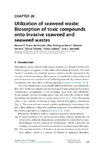Mostrar o rexistro simple do ítem
Utilization of Seaweed Waste: Biosorption of Toxic Compounds Onto Invasive Seaweed and Seaweed Wastes
| dc.contributor.author | Sastre de Vicente, Manuel | |
| dc.contributor.author | Rodríguez-Barro, Pilar | |
| dc.contributor.author | Herrero, Roberto | |
| dc.contributor.author | Vilariño, Teresa | |
| dc.contributor.author | Lodeiro, Pablo | |
| dc.contributor.author | Barriada, José Luis | |
| dc.date.accessioned | 2024-01-11T16:57:09Z | |
| dc.date.issued | 2020 | |
| dc.identifier.citation | Manuel E. Sastre de Vicente, Pilar Rodriguez-Barro, Roberto Herrero, Teresa Vilariño, Pablo Lodeiro, Jose L. Barriada, Chapter 20 - Utilization of seaweed waste: Biosorption of toxic compounds onto invasive seaweed and seaweed wastes, Editor(s): Maria Dolores Torres, Stefan Kraan, Herminia Dominguez, In Advances in Green and Sustainable Chemistry, Sustainable Seaweed Technologies, Elsevier, 2020, Pages 613-639, ISBN 9780128179437, https://doi.org/10.1016/B978-0-12-817943-7.00021-4. (https://www.sciencedirect.com/science/article/pii/B9780128179437000214) | es_ES |
| dc.identifier.isbn | 9780128179437 | |
| dc.identifier.uri | http://hdl.handle.net/2183/34841 | |
| dc.description.abstract | [Abstract] The concept of biosorption results from the “passive” (nonmetabolic) interaction of a chemical species with a particle of a biological material. This interaction can be practically exploited, for example, for removal of toxic substances of wastewaters or for the enrichment of a fertilizer with micronutrients. In this work, equilibrium and dynamic data obtained with “low-cost” biomaterials of algal waste or invasive seaweed species have been reviewed and critically analyzed in the context of a circular economy. The concept of a biosorption unit, oriented to the valorization of any solid residual material of algal biomass, can be considered as a real possibility in a biorefinery process; but to accomplish this goal it is necessary that the emphasis on research must definitely move from laboratory scale toward pilot plant assays. | es_ES |
| dc.description.sponsorship | The authors wish to thank Agencia Estatal de Investigación (AEI) (Ministerio de Economía y Competitividad) for the financial support through the research project CTQ2016-80473-P, cofounded with FEDER (UE) program | es_ES |
| dc.language.iso | eng | es_ES |
| dc.publisher | Elsevier | es_ES |
| dc.relation | info:eu-repo/grantAgreement/AEI/Plan Estatal de Investigación Científica y Técnica y de Innovación 2013-2016/CTQ2016-80473-P/ES/EMPLEO DE BIOMASA PARA EL DESARROLLO DE NUEVOS METODOS DE SINTESIS DE NANOPARTICULAS MAGNETICAS RECUBIERTAS CON POLIMEROS DE IMPRESION MOLECULAR (MMIP-NP)/ | es_ES |
| dc.relation.uri | https://doi.org/10.1016/B978-0-12-817943-7.00021-4 | es_ES |
| dc.rights | © 2020 Elsevier Inc. All rights reserved. | es_ES |
| dc.subject | Biosorption | es_ES |
| dc.subject | Algal waste | es_ES |
| dc.subject | Invasive seaweed | es_ES |
| dc.subject | Valorization | es_ES |
| dc.subject | Biorefinery | es_ES |
| dc.subject | Circular economy | es_ES |
| dc.title | Utilization of Seaweed Waste: Biosorption of Toxic Compounds Onto Invasive Seaweed and Seaweed Wastes | es_ES |
| dc.type | info:eu-repo/semantics/bookPart | es_ES |
| dc.rights.access | info:eu-repo/semantics/embargoedAccess | es_ES |
| dc.date.embargoEndDate | 9999-99-99 | es_ES |
| dc.date.embargoLift | 9999-99-99 | |
| UDC.startPage | 613 | es_ES |
| UDC.endPage | 639 | es_ES |
| dc.identifier.doi | 10.1016/B978-0-12-817943-7.00021-4 | |
| UDC.inbookTitle | Sustainable Seaweed Technologies: Cultivation, Biorefinery, and Applications |






